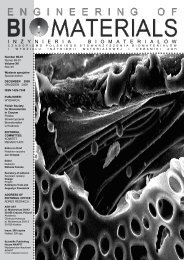69-72 - Polskie Stowarzyszenie BiomateriaÅów
69-72 - Polskie Stowarzyszenie BiomateriaÅów
69-72 - Polskie Stowarzyszenie BiomateriaÅów
Create successful ePaper yourself
Turn your PDF publications into a flip-book with our unique Google optimized e-Paper software.
86 tkanki na ekstrakcję polipeptydów wysokocząsteczkowych.<br />
Nie wykazano także istotnych różnic jakościowych w profilach<br />
elektroforetycznych tkanek trawionych PN: natywnej<br />
(Rys.1, ścieżka 2) i poddanej działaniu P (Rys.1, ścieżka<br />
4), jakkolwiek traktowanie tkanek P przyczyniało się do<br />
zmniejszenia ich podatności na ekstrakcję polipeptydów o<br />
dużych masach cząsteczkowych. W obydwóch przypadkach<br />
ujawniono brak polipeptydów o średnich i niskich masach<br />
cząsteczkowych.<br />
Profil elektroforetyczny trawionej tkanki natywnej ujawnia<br />
brak lub jedynie ślady polipeptydów o średnich lub małych<br />
masach cząsteczkowy, natomiast w przypadku tkanek stabilizowanych<br />
za pomocą TA polipeptydy te były widoczne<br />
po trawieniu PN (Rys.1, ścieżki 6,8,10). Ponieważ oddziaływanie<br />
PN na badany materiał tkankowy hamowano przez<br />
jego trzykrotne płukanie w wodzie, podczas tego etapu doświadczenia<br />
mogło dochodzić do elucji polipeptydów nisko- i<br />
średniocząsteczkowych. W przypadku tkanek natywnych<br />
lub w przypadku tkanek, w których nie osiągnięto efektu<br />
stabilizacji lub był on nieznaczny, następowała utrata tych<br />
polipeptydów. Warto podkreślić, że profile elektroforetyczne<br />
polipeptydów wyekstrahowanych z tkanek stabilizowanych<br />
za pomocą TA nie wykazują istotnego wpływu trawienia PN<br />
na ich skład jakościowy, w porównaniu z tkankami nietrawionymi.<br />
Fakt ten świadczy o efekcie stabilizacji struktury<br />
tkanki przez TA (Rys.1, ścieżki 5,7 i 9).<br />
Wnioski<br />
Badania elektroforetyczne tkanek umożliwiły udowodnienie<br />
efektu ich stabilizacji po sieciowaniu za pomocą<br />
kwasu taninowego (TA), a także po działaniu penicyliny (P)<br />
i TA, czego skutkiem było zmniejszenie podatności tkanek<br />
na ekstrakcję polipeptydów za pomocą SDS i NaCl, oraz<br />
na trawienie PN. Podatność tkanek na ekstrakcję białek i<br />
trawienie enzymatyczne jest odwrotnie proporcjonalna do<br />
efektu stabilizacji tkanek.<br />
Podziękowania<br />
Praca finansowana przez Śląski Uniwersytet Medyczny.<br />
line 7), and also P and TA (Fig.1, line 9) were observed.<br />
However, sterilization with P of TA-cross-linked tissue resulted<br />
in the increase of tissue susceptibility to extraction of<br />
high molecular polypeptides. No significant qualitative differences<br />
in electophoretic profiles of PN-digested tissues: native<br />
(Fig.1, line 2) and P-treated (Fig.1, line 4) were noted.<br />
Nevertheless, the tissues treatment with P contributed to<br />
the decrease of their susceptibility to the extraction of high<br />
molecular polypeptides. A lack of low- and middle-molecular<br />
polypeptides was revealed in both cases.<br />
Electrophoretic profile of PN-digested tissue reveals the<br />
lack or only remainders of middle- and low-molecular weight<br />
polypeptides, whereas these polypeptides were visible after<br />
PN-digestion in case of TA-stabilized tissues (Fig.1, lines 6,<br />
8 and 10). Since the influence of PN on tested tissue materials<br />
was inhibited by three-fold rinsing in water, during this<br />
stage of experiment the elution of low- and middle-molecular<br />
weight polypeptides might have taken place. In case of native<br />
tissues and tissues, in which the stabilization was not<br />
reached or was not significant, the loss of these polypeptides<br />
followed. It is worth stressing that electrophoretic profiles<br />
of polypeptides extracted from TA-stabilized tissues do<br />
not show the influence of PN-digestion on their qualitative<br />
content as compared with non digested tissues. This fact<br />
proves the stabilization of the tissue structure by TA (Fig.1,<br />
lines 5,7 and 9).<br />
Conclusions<br />
Electrophoretic examinations of tissues proved their<br />
stabilization after cross-linking by TA, and also after the<br />
treatment with penicillin (P) and TA, with resulting decrease<br />
in the tissues susceptibility to SDS/NaCl extraction of<br />
polypeptides, and PN-digestion. The tissues susceptibility<br />
to proteins extraction and enzymatic digestion is inversely<br />
proportional to the tissues stabilization effect.<br />
Acknowledgments<br />
This work was financially supported by Medical University<br />
of Silesia<br />
Piśmiennictwo<br />
[1] Gall KL, Smith SE, Willmette CA, O’Brien MF. Allograft heart<br />
valve viability and valve-processing variables. Ann Thorac Surg<br />
1998, 65: 1032-8<br />
[2] Schmidt CE, Baier JM. Acellular vascular tissues: natural biomaterials<br />
for tissue repair and tissue engineering. Biomaterials,<br />
2000, 21: 2215-31<br />
[3] Cwalina B, Turek A, Nożyński J, Jastrzębska M, Nawrat Z.<br />
Structural changes in pericardium tissue modified with tannic acid.<br />
Int J Artif Organs 2005, 28: 648-53<br />
[4] Laemmli UK. Cleavage of structural proteins during the assembly<br />
of the head of bacteriophage T4. Nature 1970, 227: 680-5<br />
[5] Gavin JB, Barratt-Boyes BG, Hitchcock GC, Herdson PB.<br />
Histopathology of “fresh” human aortic valve allografts. Thorax<br />
1973, 28: 482-7<br />
References<br />
[6] Gavin JB, Monro JL. The pathology of pulmonary and aortic<br />
valve allografts used as mitral valve replacements in dogs. Pathology<br />
1974, 6: 119-27<br />
[7] Anderegg U, Wilczek A, Haustein UF. Penicill<br />
i n G d o e s n o t a l t e r c o l l a g e n t y p e I m e t a b o l i s m<br />
of dermal fibroblasts in culture. Dermatology 2000, 200: 111-4<br />
[8] Strickett MG, Barratt-Boyes BG, MacCulloch D. Disinfection of<br />
human heart valve allografts with antibiotics in low concentration.<br />
Pathology 1983, 15: 457-62<br />
[9] Moore MA, Chen WM, Phillips RE, Bohachevsky IK, McIlroy BK.<br />
Shrinkage temperature versus protein extraction as a measure of<br />
stabilization of photooxidized tissue. J Biomed Mater Res 1996,<br />
32: 209-14













